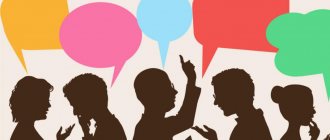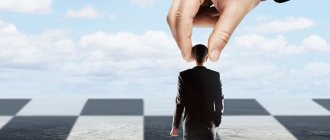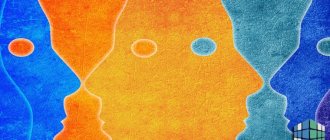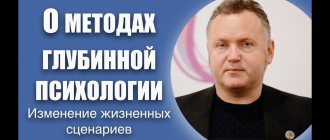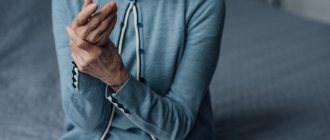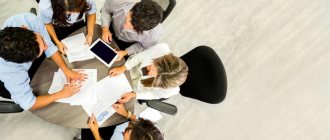Carl Gustav Jung became the second, after Adler, student of Sigmund Freud. Freud was reluctant to take on students, but from 1909 to 1913 both scientists were faithful comrades, associates, and like-minded people. Then the disagreements began. Jung refuted Freud's postulate that the human psyche is based on libido. He began his own research, based on the history of human development, the foundations of cultural studies, anthropology, religion and even mysticism.
This is how the analytical psychology of K.G. Jung, the essence of which is based on the concepts of the collective and individual unconscious, as well as personality archetypes.
Analytical psychology K.G. Jung - Fundamentals, Description
The problem of meaning... is the last analytical concept that crowns the general doctrine of the psyche, just as the concept of personality crowns the entire system of psychology.
Alexey Nikolaevich Leontyev
- 1.Basic provisions
- 2.Archetypes
- 3.Collective unconscious
- 4.Individual unconscious
- 5. Analytical psychology is primarily therapy
- 6. Contribution to modern psychotherapy
- Very simple about the subconscious
- Dementia - what is this disease?
- Schizoid and Schizoid: Signs and Causes
- Butterfly Effect - What is it?
- Paraphrenic syndrome in schizophrenia. Clinical picture
Basic provisions
Jung introduced new concepts into terminology that define the profound influence on the formation and formation of a person’s personality.
In a psychiatric clinic, under his supervision there were several dozen people with various mental disorders. Working with patients, Jung came to the conclusion that the integrity of the human psyche is not determined only by his consciousness.
There are systems that form the structure of personality under the influence of external and internal factors. These systems formed the basis of his teaching.
Carl Jung (1875-1961)
Education
At the age of 11, Jung was sent to the Basel gymnasium. Through the efforts of his father, at that time he already knew Latin quite well and, it would seem, being already ahead of his peers, he should have studied successfully. However, he showed no interest in science, and only read ancient books or enthusiastically drew ancient castles. As he himself said, this was caused by a feeling of dual personality that did not leave him - he claimed that since childhood he had “ two selves
.”
By the age of 16, both loneliness and bouts of depression gradually began to subside. Fascinated by philosophy, Jung immersed himself in reading Pythagoras, Heraclitus, Plato, and he even found reflections of his thoughts in the works of such a German philosopher as Arthur Schopenhauer.
At the age of 18 he entered the University of Basel, the Faculty of Natural Sciences. Due to the death of his father, there was no one in his family to bring money, so in his free time from studying, he worked as a tutor, which paid for his studies and a rather modest existence.
At the same time, he became interested in the works of such mystical philosophers as Emmanuel Swedenborg and Adolf Eschenmayer, and there were even several spiritualistic seances. Oddly enough, this helped him write a dissertation on medicine, which was called: “On the psychology and pathology of so-called occult phenomena.”
He returned to this again, still for research purposes, in order to correctly formulate commentaries on such texts as the I Ching, The Secret of the Golden Flower and The Tibetan Book of the Dead.
The “Textbook of Psychiatry,” authored by Richard von Krafft-Ebing, which came before the final exams, determined the further receipt of a medical degree in psychiatry. Jung " suddenly understood the connection between psychology, or philosophy, and medical science
».
It is worth mentioning that the phrase “ Whether called or not, God is always present”
“he not only included it in his bookplate, but much later ordered it to be carved on the stone arch that was located above the front door. The Christian Church will condemn his works more than once, but he himself will remain a deeply religious person.
At the age of 21, he first met his future wife, Emma Rauschenbach, from an old German-Swiss family. Gustav immediately liked the sweet, modest girl with thick hair neatly braided into a braid.
Archetypes
K.G. Jung on archetypes Under the influence of the collective unconscious, a person develops a general model of perception of the world, which is laid down in childhood. Jung defines the following types of archetypes:
- The ego
is the center of self-awareness through the interconnection of the collective and individual unconscious. If the connection is broken, then the human psyche begins to collapse. - A persona
is a “mask” in which a person appears in society. Each individual can have an infinite number of personas. They include demeanor, communication style, character, and presentation of oneself in society. - Anima and Animus
are the feminine and masculine principles. The less Anima in a man, the more rude and primitive he is. The more animus in a woman, the less inclined she is to pity, patience, and compassion. Jung believed that in old age both principles are balanced and a person enters a phase of harmony. In this way he gains wisdom. - Shadow
– hidden subconscious fears. They were formed in childhood. Then they transformed into complexes. Throughout his life, a person suppresses his secret desires, dreams, and fears. If you find harmony with the Shadow, then the feeling of shame for your childhood fears will go away and the person will be able to find a common language with society. - Self
– the main archetype that organizes and protects personal integrity. Thanks to him, the individual finds compromises and ways to eliminate contradictions. A person can independently direct his own negative traits into a positive direction. For example, aggressiveness can develop into a desire to achieve goals (in business, sports, art and other areas of activity).If the self does not cope with the assigned tasks, internal conflicts arise. They can lead to mental disorders. Then psychotherapy comes to the rescue.
Role for the individual. Integration
According to Jung, people confuse self-knowledge and knowledge of their Ego, which gives rise to destructive illusions. It seems to them that awareness of the contents revealed in the Ego is already an achievement. Jung compared this opinion to how the average person, living in and with the body, knows practically nothing about its anatomy and physiology.
To learn the anatomy of the psyche, to know yourself, you need to touch the unconscious - and not only personal, but also collective. The majority more often bounces away from the unconscious and does not strive to penetrate a little deeper than a naive opinion about themselves.
Reasoning, Jung was surprised at how the idea of the supremacy of consciousness fits into people's minds. The unconscious has led man over many millennia to the present day; it clearly has greater wisdom and is perfectly adapted to the environment.
We recommend: Higher mental functions
True motives, true desires, true fears - this is what Jung calls the difference between true self-knowledge and a mask. It is through it that you can get closer to conscious existence and a fulfilling life.
The main purpose of the Ego is to establish contact with the archetype of integrity - the Self. The latter is understood as the central principle of the organization of the psyche - a fundamental and important aspect of human personality, giving unity, meaning, direction and purpose.
The process of individuation is a key concept in Jung's analytical approach. This is a natural process of personality development, which includes a gradual movement towards the manifestation of all the true elements of personality. This process is never complete, since the personality is a dynamic system.
Individuation allows you to establish contact between consciousness and the unconscious. As soon as a primary connection is established with the contents of the unconscious left far behind, the Self begins to emerge. If you continue to run away from unconscious contents, they will capture a person and overthrow him.
But if you try to integrate the contents, then internal unity and individuality are achieved. Therefore, Jung considered the process of individuation as a path to oneself, self-realization. The process of individuation can roughly be described as follows:
- Awareness and analysis of Persona.
- Approaching the Shadow, abandoning projections.
- Contact with Anima/Animus.
- Integration of contents, development of the Self.
Jung considered the most difficult stage of finding oneself to be the revelation of our Shadow. Associated with it are elements that we consider negative. We don’t want to interact with it, we don’t want to recognize the Shadow as ours. But repressed ideas and thoughts are not always negative: for example, we can repress what we consider to be weaknesses - the ability to sympathize, experience, sensitivity, gentleness.
According to Jung, a person does not achieve integration at once; it is a dynamic process in which he constantly moves from one level to another, comprehending more and more deeply what is beyond the threshold of consciousness. In general, Jung believed that the processes of transformation are already in our unconscious, so a psychological crisis is often resolved naturally. To decipher the messages of the unconscious and get rid of problems as successfully as possible, you should simply listen to sensations, feelings, and impulses.
Collective unconscious
Personality is formed under the influence of the experience of previous generations of humanity.
Ethnic groups, nationalities, nations and races did not appear out of nowhere. They were created on the basis of general concepts about life, the formation of common mental images, which later became the basis for religious beliefs, culture, and philosophy. The collective unconscious influences the formation of rules of behavior, mentality, and actions adopted for society as a whole. Thus, it determines the fate of the individual in society. The connection can be traced at an intuitive level and is therefore difficult to explain.
This unconscious has not an individual, but a general nature of content and behavior. It contains historical, ethnic, sociocultural, and family foundations.
VASCULAR MOTOR CENTER
Activity
Having moved to Zurich, in 1900 he entered a clinic for the mentally ill, as an assistant to the author of the term “schizophrenia” - Eugene Eugene Bleuler. Having settled in Blade territory, he soon began to publish his first clinical works, as well as articles that revealed the use of the word association test, which he himself had developed. The collected clinical material supplemented the observations made during spiritualistic seances, which made it possible to publish a book of the same name as his dissertation.
«The split personality of the spiritualist medium goes back to certain inclinations in infancy, and the presence of manic sexual desires can be traced to the basis of hallucinatory systems
“,” noted Jung.
Repeatedly referring to such works of Freud and Bleuler as “The Interpretation of Dreams” and “Studies on Hysteria,” he already then clearly defined the direction of his future work, in particular, its deviation from Freud’s position.
On February 14, 1903, Carl Jung married Emma Rauschenbach. She always showed a sincere interest in her husband's work and supported him in everything, and given her financial status, Jung could devote his time entirely to research. In 1904, his wife gave birth to his daughter Agatha.
On August 17, 1904, 18-year-old Sabina Spielrein was admitted to the clinic. The relationship between doctor and patient quickly developed into that of lovers, and their relationship became public knowledge. Jung appreciated the girl’s sharp mind and scientific way of thinking, and Spielrein could not help but fall in love with the doctor, who had a keen sense of the world. However, immediately after the illness was cured, Sabina left the clinic, and the relationship ended.
In 1906, his wife gave birth to his second daughter, Greta. In the same year, he published the book “The Psychology of Dementia Early,” which began with one of the best reviews of the theoretical literature of that time on this topic. He based his position on a synthesis of the ideas of various scientists, including Kraepelin, Janet, Bleuler and Freud. Adherents of the latter spoke about the book like this:
«...made a revolution in psychiatry
" - Jones.
«...became the cornerstone of modern interpretative psychiatry
" - Brill.
Jung also earned a reputation as the pioneer of the psychosomatic model of this disease. According to his theory, the characteristic symptoms of dementia praecox are the result of a brain-damaging toxin that is produced as a result of affect. He later abandoned this hypothesis in favor of the more modern concept of a disorder of chemical metabolism.
«...it is impossible to do without psychology when explaining the causes and nature of primary emotions that cause changes in metabolism. These emotions appear to be accompanied by chemical processes that cause specific short-term or chronic changes or damage to organs
", he wrote in 1958.
With his book, Jung drew widespread attention to the theories of Freud, "an almost unrecognized researcher
", and before finishing his book, in April 1906, he began correspondence with Sigmund himself, to whom he sent a copy of his book.
At the end of February 1907, Jung went to Vienna to meet Freud, along with his wife and freelance doctor Ludwig Binswanger. The first conversation, which he later called “ a review of horizons”
", lasted 18 hours without a break.
According to Jung, Freud " is impressive and at the same time he is 'strange' for a man of his qualifications
."
In a letter intended for Abraham, Sigmund wrote about Jung: “ Only his appearance on our stage saved psychoanalysis from becoming a national Jewish enterprise
.”
He saw in him " Jesus, destined to explore the promised land of psychiatry
", and he himself, "
like Moses, could only look at it from afar
."
A few months later, Jung founded the Freudian Society in Zurich. And the report in defense of psychoanalysis, “The Freudian Theory of Hysteria,” which he read at the first International Congress of Psychiatry and Neurology in Amsterdam, essentially turned into an apology for Freud’s ideas.
In 1908, his wife gave birth to his son Franz, and Jung organized the first International Congress on Psychoanalysis in Salzburg and founded the Yearbook of Psychoanalytic and Pathopsychological Research, which he became editor, and Freud and Bleuler co-directors.
In 1909, Jung and Freud arrived in the United States, where he gave a course of lectures. In the same year, 21-year-old Toni Wolf came to Jung as a patient, and after her recovery she became his official mistress and also his assistant. In September 1911, she even accompanied the Jung family to the Weimar Congress of the International Psychoanalytic Society. Toni accompanied him in life and work for 40 years; together they published the book “Metamorphoses and Symbols of Libido.” The wife was well aware of this affair, but her boundless love for her husband did not allow her to file for divorce.
In 1910, he resigned as director of the Burgelzli Clinic, after which Jung returned to his native land and plunged into in-depth research into myths, legends, and fairy tales in the context of their interaction with the world of psychopathology. During the Nuremberg Congress, the International Psychoanalytic Association was founded, of which he was elected president. He became the first and youngest president of the association in its history, even despite the angry protest of the Vienna group. That same year, his wife gave birth to his daughter Marianna.
The articles published during the years of defending Freud's theories no longer sparkled with the same originality, and Jung himself began to feel growing anxiety. In 1907-1910 he was visited by such Moscow psychiatrists as Mikhail Asatiani, Nikolai Osipov and Alexey Pevnitsky, all at different times. In 1911, the book “Metamorphoses and Symbols of the Libido, Part I” was published, in which he tried to apply the principles of psychoanalysis to myths, legends, fables, classical plots and poetic images, and in 1912 the second volume of the book was published. In his books, Jung deprives “libido” of sexual connotations, contrary to Freud’s ideas. In The Psychology of the Unconscious, published the same year, he refuted many of Freud's ideas.
He identified the collective unconscious, contrary to Freud’s opinion, expanded and supplemented the concept of “complex”. Jung's ideas related to philosophy, astrology, archaeology, mythology, theology, literature and psychology, and their result was analytical psychology. He also believed that everyone has “ a complete personality sketch... presented in potency from birth
“, and “
the environment does not at all give the individual the opportunity to become one, but only reveals what was already inherent in it
,” which contradicted a number of provisions of psychoanalysis.
Freud's ideas for the most part influenced him in the period before his personal meeting, but he himself did not retreat from mysticism, where the idea of the collective unconscious arose from his first work. The relationship between them soon became purely business, and in September 1913 they decided to end all communication, meeting for the last time at the International Congress in Munich, where Jung was re-elected to the International Psychoanalytic Association.
The drama of the separation turned into an opportunity for Jung to publish such works as “Symbols of Transformation” and “The Red Book.” A month later, he resigned as editor of the Yearbook of Psychoanalytic and Pathopsychological Research, and in April 1914 he left the International Psychoanalytic Association and no longer used the technique of psychoanalysis in his practice.
In July 1914, “The History of the Psychoanalytic Movement” was published, in which Freud showed the complete incompatibility of his ideas with the views of Jung and Alfred Adler. After this, the entire Zurich group left the International Association. That same year, Jung's wife gave birth to his last daughter, Helena.
In analytical psychology, Jung, in contrast to Freud, who concentrated on the dissatisfaction of sexual desires, digs deeper and wider, consistently developing and refining all the ideas created before him, including the best of Freud’s works.
In the 1920s he made a series of long trips to areas of Africa and North America. In 1921 he published the work “Psychological Types,” in which people were divided into introverts and extroverts, and the theory of archetypes was substantiated for the first time.
In 1922, after the death of his mother, he purchased a lakeside estate in Bollingham, not far from his home in Kusnacht, where he built the “Tower” for many years. Initially it was only a primitive round stone dwelling, but later it took on the appearance of a small castle, with two towers, an office, a fenced yard and a boat dock. In his autobiography, he described the construction process as “ an exploration of the structure of the psyche embodied in stone.”
" Throughout his life, he often stayed for long periods in the Tower, researching, painting and sculpting.
In 1930, Jung received the title of honorary president of the Psychotherapeutic Society of Germany and published the book “Problems of the Soul of Our Time.” In 1932 the council of Zurich awarded him a prize for literature with a check for 8,000,000 francs. In 1933 he became one of the inspirers and active participants in the International Intellectual Community "Eranos". In the same year he became a professor of psychology at the Federal Polytechnic University in Zurich.
From 1933 to 1939 he was the publisher of the Journal of Psychotherapy and Related Fields, which supported a national policy of racial purification, and the prologue to each publication invariably contained an excerpt from Mein Kampf. Later, in 1948, he mentioned in an interview with Karol Bauman that “ among his colleagues, acquaintances and patients in the period from 1933 to 1945 there were many Jews
" Jung himself claimed that this was a forced measure and was not officially convicted.
In order to study the traces of ancient civilizations, he visited the Indian Pueblo settlements located in the states of Arizona and New Mexico; at the extinct volcano Elgon, located in British East Africa; as well as in Egypt, India and Sudan. And after that I read reports at various international congresses.
He returned to teaching, giving weekly lectures at the ETH Zurich, and in 1937 he lectured on the relationship between psychology and religion at Yale University. In 1944 he became a professor at the department of medical psychology, which was specially dedicated to him at the University of Basel. He didn’t work there for long - in February he broke his leg during an excursion, and already suffered a heart attack in the hospital. The visions that visited him in those few weeks that he teetered on the brink between life and death were described in detail in his autobiography.
In April 1948, the Jung Institute was organized in Zurich, where training was conducted in English and German. Also, supporters of his method created the Society of Analytical Psychology in England, and similar ones in the USA and a number of other European countries.
In 1950, in honor of his 75th birthday, he installed a stone cube to the west of the Tower, on three sides of which he carved inscriptions. On the first - “ Here lies a stone, it is inconspicuous, its price is ridiculously low. But the wise appreciate what fools despise
" from "Rosarium philosophorum" and "
In memory of his 75th birthday, C. G. Jung gratefully made and installed, in the year 1950.
" On the second is Telesphorus, holding a lantern in his hand, around which an inscription in Greek is carved. On the third there is an inscription in Latin.
In 1955, in honor of his 80th birthday, he was elected an honorary citizen of Kusnacht, which he himself valued above election as a member of the Royal Society of Medicine in London. In November of the same year, Emma passed away, which completely devastated Jung. He immersed himself in his work, and his autobiography, recorded with the help of a secretary, took up a lot of his time. Over time, he had to hide bundles of letters behind bookshelves, because there was no time left for them.
In 1958, a congress on analytical psychology was held in Zurich - it was the first international congress, in which 120 delegates took part.
In May 1961, Jung had a new heart attack while walking, which caused blockage of blood vessels in the brain and partial paralysis of the limbs. After several weeks, during which he was again on the verge between life and death, the day before his death, he had a dream, after which he declared with a smile that he was no longer afraid of anything.
He died on June 6, 1961 at his home in Küsnacht. He was buried in the Protestant church cemetery, and the tombstone bore not only his initials, but also those of his parents, sister Gertrude and wife Emma.
Individual unconscious
An individual personality type is formed on the basis of personal experience.
Experience is gained by receiving information from the outside (extroversion) or by immersing oneself and one’s own rethinking of the events that have occurred (introversion). During his research, Jung divided the information a person receives into two systems:
- Ectopsychic
- connected with the external world and includes sensations, thinking, feelings and intuition; - Endopsychic
- associated with the inner world and includes memory, emotions and affects.
Through knowledge of the unconscious, a person goes through the process of self-realization.
A person becomes an independent unit. This is interesting
: It is believed that under the influence of the dominant function a certain psychological type is formed - an extrovert or an introvert, and also the main types of characters are formed (choleric, melancholic, sanguine, phlegmatic).
Analytical psychology is primarily therapy
Jung was a practicing psychotherapist, so all his discoveries were created by him on theoretical conclusions and practical application.
Jung devoted his entire life to creating a method of working with the unconscious. He believed that positive results can only be achieved with complete trust between the patient and the doctor. Therefore, he practiced conversations, encouraged any kind of creativity, helped the patient build new, more comfortable relationships with others, projecting them onto the doctor.
To understand the unconscious, Jung used the following methods:
- Association test
. In the process, stimulus words are identified that cause painful heightened feelings. You can find out what worries a person at the subconscious level by re-reading the associative series and putting the words together. - Dream analysis
. Jung paid special attention to this method. He considered dreams to be a manifestation of the position of a self-regulating mental system. This unconscious warns a person about imbalance. To interpret dreams, Jung used the amplification method (searching for parallels with well-known motifs in art, culture, literature, religion). - Active imagination
. Jung considered creativity to be one of the most effective therapies.
For reference:
According to the psychotherapist, working with directions should harmonize the relationship between the conscious and unconscious in a person.
Evidence from our time
For a long time it was believed that nothing except the genotype is physically transmitted from one person to another. Genes do not change from lifestyle. How else can information about the life of ancestors appear at the organism level?
It turned out that it could very well. This was shown by a study conducted in 2014, the results of which were published in Nature Neuroscience. Depending on what experience the mice had, their offspring behaved differently: their reactions differed from the control group of mice, they reacted to stimuli associated with the past of their ancestors, as if they themselves had experienced something similar to their parental experience in their lives .
We recommend: Depth Psychology
Scientists explained it this way: the genome indeed remains unchanged, but something changes: the expression of a particular gene associated with the experience of the parent mouse. The expression of a gene affects the sensitivity of certain cells in the body with which it is associated. And this in turn changes sensations, reactions and feelings.
There's something else worth adding. Firstly, the reaction to the stimulus that the first group of mice had was also observed in the grandchildren of these mice. Secondly, neither the second nor the third generation was presented with a repeated stimulus, but the reaction was still noticeable. But people have been exposed to similar strong stimuli for millions of years, so the reactions should only be strengthened.
All this was not known in Jung’s time, and he could hardly have foreseen such a turn of events. He believed that any experiments to prove the existence of the collective unconscious and its images were impossible.


